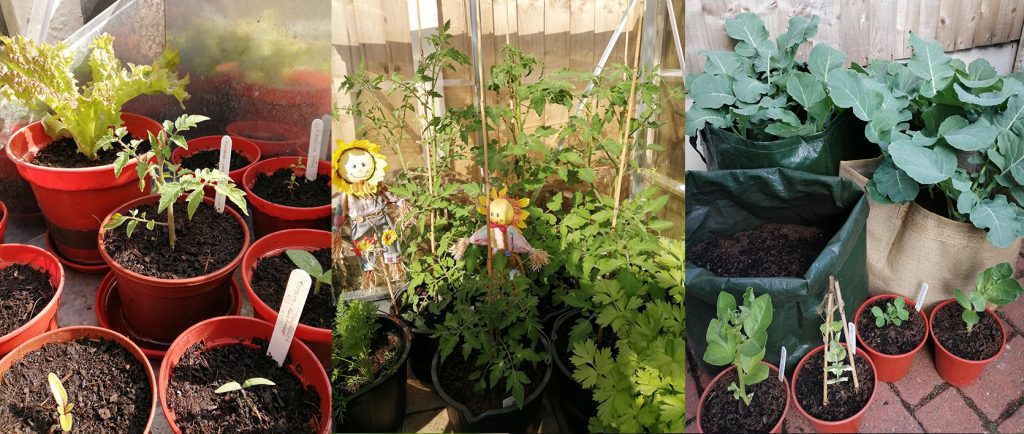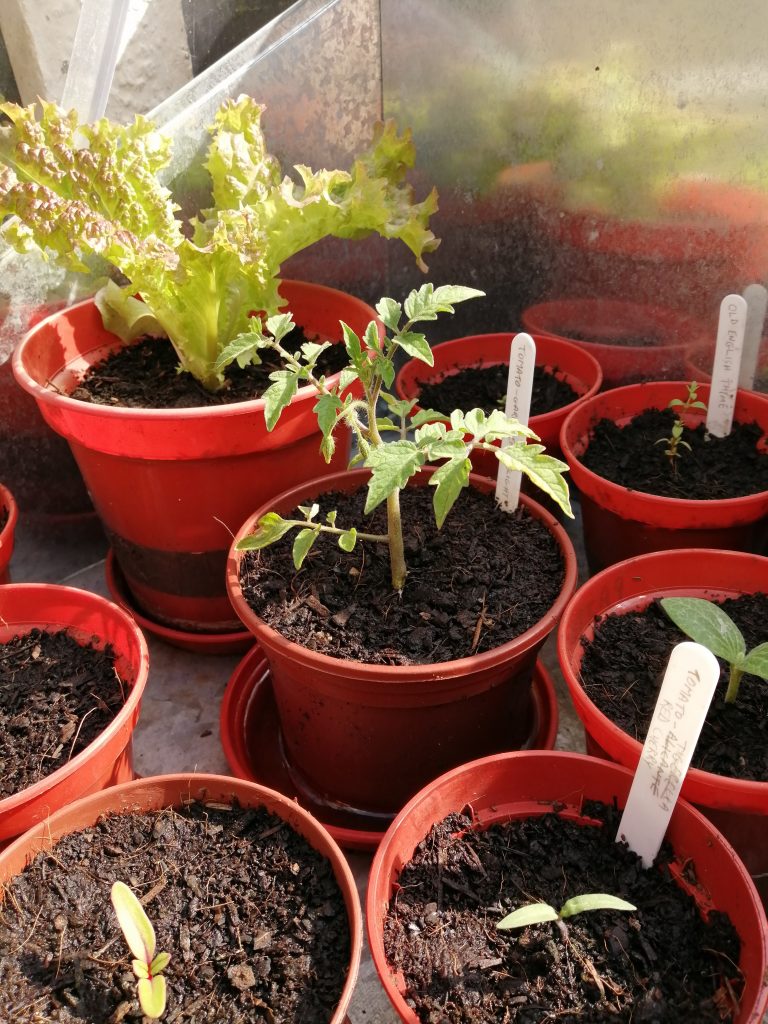This week, the UK is celebrating National Growing for Wellbeing week! It’s a celebration of the magic that growing your own produce can do for your wellbeing, both physically and mentally.
AOer and Front End Developer Emma offered her story on how she began growing her own produce, and some really helpful tips and hints to get you started!
Like a lot of other people, I’ve taken to gardening during lockdown. It provides an escape, a way to disconnect when needed, and with little else changing in my environment these days, even seeing a new shoot poking through the soil is a thrill.
This isn’t my first venture into the world of growing, I’ve had an on-off (occasionally turbulent!) relationship with gardening since I was a teenager when I bought a packet of rose seeds on a whim despite knowing nothing about gardening or roses.
It’s taken 10 years since my love for gardening started before I made a serious effort to grow my own veg at home. This began with an investment of £40 and ended several months later with a solitary courgette. Every other plant fell to an aphid army or failed to crop.
To this day, it remains the most expensive vegetable I’ve ever eaten.
Since then I inherited twelve 6ft tall tomato plants, four potato plants and a rose bush which all made the perilous journey from Holyhead to Liverpool on one of the hottest days of the year. As it happened, this all coincided with a strange, stressful time and a friend had encouraged me to get involved in the community garden she was part of.
I was retraining in construction skills after running a photography business for several years and was pretty much broke, so I went along hoping it would improve my health and happiness. This was the first time I really understood the reward of digging in the soil, being patient, paying attention to the relationship between plants and the elements and finally, enjoying the crop after all the hard work.
Finally success! The tomato and potato plants survived, yielding bumper crops. I think we used every tomato and potato recipe in the house that year. The rose bush and I never saw eye to eye, perhaps it didn’t like suddenly being confined to a container, although I have my suspicions that having a patriotic Welsh owner its whole life, it may also have resented being uprooted to England.
For several years after that, I grew fruit and veg at home. Tomatoes and potatoes are my forte. I don’t have any soil and despite being able to build raised beds, I haven’t got round to it yet. I still grow them in ordinary buckets, just like those first tomato plants.
Varieties like Gardener’s Delight and Moneymaker are resilient and forgiving. They will tolerate a certain amount of mistakes and learning and still thrive. While I have grown them from seed, young plants are much easier to start with. I tend to leave them in pots until they look too big and then move them up to the next size, taking care not to touch the roots by placing my hand flat on the top of the soil with the stem between my fingers, then turning the pot upside down to turn the plant out of it.
Overwatering and underwatering in tomatoes look quite similar; blisters on the leaves which eventually turn yellow and dry. If you push a trowel 2-3 inches into the soil and it comes up damp, it shouldn’t need watering.
Other problems include blossom end rot, where the fruit turns brown on its base, and pests such as blackfly. Taking care with watering and using a good tomato feed usually prevents rot for me and I generally rely on companion planting to limit pests. French Marigolds are thought to be most effective, but I wasn’t able to find any this year. Interestingly, I’ve noticed fewer pests this year while growing celery next to my plants. It may be coincidental, but worth keeping an eye on.
Unlike bush varieties like cherry tomatoes, these can grow to 5-6ft tall and have grown best for me in a greenhouse. To keep the plant growing upwards and investing the most energy into producing fruit, pinch out the shoots that appear between branches off the main stem. Often, if I want more plants, I’ll stick these straight into a pot of compost and it will root and grow. It doesn’t always work or maybe doesn’t yield as much fruit but it’s a handy way to add a little more to the crop.
This year I wasn’t able to find seed potatoes, so I took a few of the smallest from a bag of supermarket potatoes and left them to chit (sprout shoots) before putting them into a growbag. As the shoots appear, I’ll keep topping up the compost, covering the shoots until they get too big and leafy. This encourages the plant to produce more tubers. Horse manure is the best fertiliser, but I’ve always managed to get a good crop without it.
It’s entirely possible I won’t get anything from these supermarket potatoes, but this is where patience and pragmatism are important. I may invest months of time and effort only to end with plants that don’t produce a single potato (or only a single, mocking potato) but the great adventure of doing so is also part of the reward. And if it pays off, I may well be having homegrown roast potatoes on Christmas Day.
If you want something that offers results a little sooner and with less effort, salad is a great place to start. I sprinkle a small pinch of seeds over a pot of compost and cover them with a light dusting of compost and a tiny bit of water. After about three weeks, baby leaf salad is ready to cut from the plant and used. I’ve read that you should leave at least four of the new leaves on the plant to keep growing and if you have space, sowing new seeds every two weeks will keep a constant supply. Pea shoots, in particular, are lovely. You can buy specific pea shoot salad peas to plant, but people have had success planting dried peas bought in the supermarket, these are much cheaper.
Herbs are best grown on from young plants, they can be difficult to nurture from seed though it’s always worth a try and I’ve had success with growing Thyme this year, by keeping the pot covered with cling film until the shoots are a few mm tall. Chives are another good option, they grow quite easily from seed and if you harvest them regularly by cutting close to the base, it will encourage new growth. Most herbs can be sown the same as salad and once the seedlings are a few mm tall and look strong, can be transplanted into individual pots. Depending on their origin, different herbs like different levels of heat, for example, Thyme is a Mediterranean plant and so loves direct sunlight and minimal watering.
Mint, on the other hand, enjoys the shade and some varieties require protection from direct sunshine. It also prefers moist, but not waterlogged, soil. It’s very difficult to grow from seed so young plants are best. I’ve found it easy to grow from cuttings by putting it into a small glass of water until roots appear. It’s very invasive, so if you plan to plant it in the garden, make sure you keep it in a bottomless container to restrict the roots. There are so many interesting varieties of mint, Chocolate Mint has a slight After Eight taste whereas Spearmint tastes like chewing gum. Peppermint is lovely for tea, just take a few leaves off and pour over hot water. Let it brew for a few minutes and then enjoy! Another herb that makes lovely tea is Lemon Verbena; iced is perfect for hot Summer days to cool down, while hot is cosy and comforting for the colder months to keep you motivated to keep getting out into the garden and finish the jobs that need doing.
The quiet, consistent work required to grow your own plants and food at home is the perfect way to switch off. It can be as small as you like, just one plant; or it can be a whole allotment plot. Both encourage us to slow down and engage with nature for a little while. When I turn off my laptop and walk into my greenhouse, particularly on warm wet days, listening to the drumming of raindrops on the plastic roof, surrounded by the heady scent of tomatoes, I’m transported far away. There is only the plants and the same simple things they always require to keep growing.
It’s all an experiment and when one thing doesn’t work, try another. During difficult and stressful times, the persistence of that plant is something positive to focus on, even if just for a few minutes every day.



